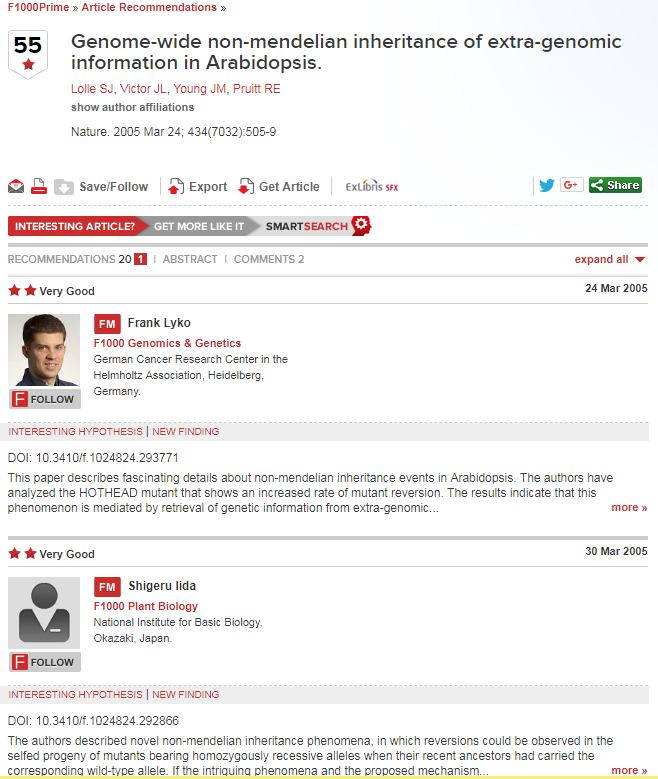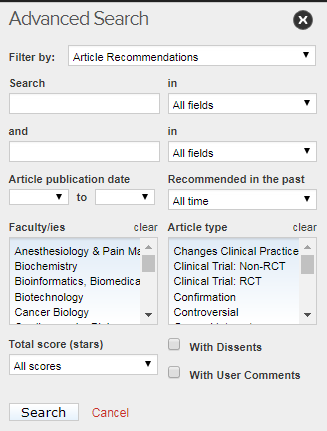Electronic Resources Reviews
F1000Prime: Expert Recommendations of Journal Articles in Biology and Medicine
Katherine G. Akers
Biomedical Research and Data Specialist
Shiffman Medical Library
Wayne State University
Detroit, Michigan
katherine.akers@wayne.edu
F1000Prime is a subscription-based article recommendation and literature discovery service that helps readers sift through the thousands of journal articles in biology and medicine published each day. F1000Prime is a product of F1000 (Faculty of 1000), a company based in the United Kingdom that also provides F1000Workspace (a multi-functional reference management and collaboration tool) and F1000Research (an open research publishing platform). F1000 was launched in 2000 by Vitek Tracz, the founder of the open-access publisher BioMed Central (BMC).
Content
The main content of F1000Prime is nearly 200,000 recommendations of journal articles within biology and medicine written by F1000Prime Faculty, which consists of approximately 90 Heads of Faculty, 800 Section Heads, 4,000 Faculty Members, and 3,000 Associate Faculty Members from 67 countries (54% North American, 34% European, 7% Asian, and 5% other). Heads of Faculty are eminent leaders in their fields who oversee broad subject domains and appoint Section Heads to cover narrower topic areas (i.e., sections), who in turn appoint Faculty Members and provide editorial oversight. Faculty Members are expert faculty researchers who review the literature in their section on a continual basis and highlight the most interesting articles by writing article recommendations. Associate Faculty Members are predominantly junior faculty and postdoctoral researchers who assist Faculty Members in identifying and recommending articles. Together, F1000Prime Faculty recommend approximately 1,200 articles per month (Gray 2018). Faculty Members are not paid for their work, but receive free subscriptions to F1000Prime and F1000Workspace, along with other benefits.
An article recommendation consists of a star rating (3 stars = exceptional, 2 stars = very good, 1 star = good); one or more tags marking articles as "changes clinical practice," "confirmation," "controversial," "good for teaching," "interesting hypothesis," "new finding," "novel drug target," "refutation," or "technical advance"; and a brief review of the article, the reason for its recommendation, and its potential implications. A "dissenting opinion" can also be posted if a Faculty Member thinks an article should not have been recommended or that its recommendation was not sufficiently critical. Each article can be recommended by more than one Faculty Member, with an article's total score being a summation of the star ratings received from all recommending Faculty Members. In this manner, F1000Prime ranks articles within particular sections and across all sections. For example, the currently highest-ranked article on F1000Prime across all sections (Lolle et al. 2005) has 55 stars resulting from the cumulative recommendations of 20 Faculty Members, as well as one dissenting opinion from another Faculty Member (Figure 1).

Figure 1. Screenshot of F1000Prime article recommendations for the highest-ranked article.
Article recommendations can be searched using basic or advanced search interfaces. The advanced search interface (Figure 2) allows search terms to be restricted to 17 different fields (e.g., recommendation text; Faculty Member name or affiliation; article title, abstract, author name or affiliation; journal name; funding information) and results to be filtered by article publication date, subject domain, article type (i.e., study design or classification tag), and total score, among other options. Article recommendations can also be browsed within sections or using lists of article rankings within or across sections, including "all-time top 10," "current top 10," and "hidden jewels" (i.e., highly recommended articles from specialized journals as opposed to multidisciplinary scientific journals like Nature or Science).

Figure 2. Screenshot of F1000Prime advanced search interface.
Currently, the areas in biology and medicine with the most F1000Prime article recommendations are cell biology (n = 60,485), molecular medicine (n = 55,062), genomics and genetics (n = 40,132), biotechnology (n = 36,611), pharmacology and drug discovery (n = 32,997), biochemistry (n = 28,888), structural biology (n = 24,387), microbiology (n = 22,988), neuroscience (n = 22,637), developmental biology (n = 21,296), and chemical biology (n = 21,073). Other coverage areas include bioinformatics, ecology, evolutionary biology, and plant biology as well as 20 medical specialties, from anesthesiology to neurological disorders to urology.
Article Recommendations
In response to inadequacies of traditional peer reviews and connected to an increasing online discourse on scientific research, post-publication peer review allows other academics or the general public to comment on the strengths and weaknesses of journal articles after they are published (Tennant et al. 2017). F1000Prime is arguably the first of many post-publication peer review platforms that include PubPeer, Science's eLetters, Publons, The Winnower, ScienceOpen, and several now-defunct platforms. Different from other platforms, however, F1000Prime is the largest, most easily searchable collection of recommendations of journal articles written exclusively by leading researchers. Also, whereas some post-publication peer review platforms may in part be used to identify scientific errors or misconduct and thus play a role in the retraction of journal articles (Retraction Watch 2017), F1000Prime consists almost entirely of positive reviews that draw attention to the most interesting and important work.
An F1000Prime article recommendation can be considered a member of the "altmetrics" family -- article-level measures of research impact that serve as alternatives to traditional bibliometrics such as citations or journal impact factor (Priem et al. 2010). Anecdotal accounts also indicate that F1000Prime article recommendations (or Faculty Member appointments) can be used to strengthen an author's application for research funding, a new job, or tenure and promotion (Bergman 2011; Poynder 2015).
Literature Discovery
Given the thousands of journal articles in biology and medicine published each day, it can be difficult -- if not impossible -- for an individual researcher to effectively monitor the literature in their field. As one solution to this problem, F1000Prime serves as an expert "human filter" (Wets et al. 2003) that highlights only 1-2% of journal articles, making it possible for a researcher to stay abreast of the most important new findings in their primary and secondary research areas. Furthermore, articles recommended in F1000Prime come from nearly 5,000 journals (Shanahan 2018), indicating that recommended articles are judged by their own merits rather than by the journal in which they were published. In other words, F1000Prime article recommendations do not simply duplicate the tables of contents of Science and Nature; rather, over 85% of recommended articles do not come from "top-tier" journals, underscoring the fact that good research can be published in any journal.
F1000Prime can be used as a literature discovery tool in several ways. After creating a MyF1000Prime account, users can select certain keywords that describe their areas of interest and particular sections that encompass their research fields. F1000Prime then learns about the user from their interactions on the site to hone its e-mail alerting service to highlight new articles published directly in the user's area as well as those in tangential fields that might not appear in basic searches but could be of considerable value and interest to the user (Shanahan 2018 Users can follow particular Faculty Members or articles. Furthermore, F1000Prime offers the intelligent F1000 SmartSearch tool to discover recently published journal articles within user-defined areas of interest. Users first seed the SmartSearch tool with the PubMed IDs of several journal articles on a certain topic, which the SmartSearch algorithm uses to identify potentially relevant articles in PubMed, regardless of whether they were recommended in F1000Prime. Users then indicate the frequency with which they would like to receive e-mail alerts about new articles and have the option of training the algorithm by indicating whether each returned article citation is relevant or not relevant.
Resources for Librarians
F1000Prime provides a collection of librarian resources, including guidance for configuring OpenURL link resolvers and PubMed LinkOuts and obtaining COUNTER usage reports, boilerplate text for use in library catalogs and LibGuides, instructional YouTube videos, and promotional materials (e.g., digital flyers, postcards, posters, and logos).
Criticisms
F1000Prime has been criticized as being an "in club" of researchers who may engage in cronyism by selectively appointing their friends or collaborators as Faculty Members or preferentially recommending articles written by close colleagues (Bergman 2011; Wardle 2010). However, F1000Prime reduces potential bias in article recommendations by attributing all recommendations to named Faculty Members and requiring that Faculty Members cannot recommend articles they have written and must disclose any potential competing interests. Another criticism of F1000Prime is that it is not open access and -- like so many other journal publishers and related companies -- sells the intellectual work of Faculty Members back to institutions that already paid for their labor (Bergman 2011), although it could be argued that the expert recommendations by Faculty Members provide value to F1000Prime users that is not otherwise captured in their daily academic work.
Price
F1000Prime is available through an individual subscription (30-day free trial, $9.95/month, 50% discount for students), a lab subscription (for individual laboratories or departments, starting at $300/year), or an institutional subscription. The price of an institutional subscription is based on the full-time equivalent (FTE) count of faculty, postdoctoral researchers, and graduate students in the life sciences and medicine, corresponding to its primary user population. In 2015, the average price of an institutional subscription to F1000Prime was approximately $9,300/year (Poynder 2015).
Summary
Although perhaps not a "must-have" resource, F1000Prime holds substantial value as an article recommendation and literature discovery tool for users at universities and other research institutions. Although its primary audiences are individuals engaged in scholarly research in biology and medicine, including faculty, postdoctoral researchers, and graduate students, secondary user populations include medical practitioners (e.g., physicians, residents) and undergraduates completing coursework in the life sciences and biomedicine. Although other post-publication peer review platforms have come and gone, F1000Prime has stayed alive and active for over 15 years and promises to continue evolving to meet the research dissemination and literature discovery needs of scientific researchers.
Acknowledgements
Thanks to Miranda Gray, Daniel Shanahan, Steven Lokwan, and Leanne Elliott for discussions about F1000Prime and providing critical comments for this review.
References
Bergman, Casey. 2011. Goodbye F1000, Hello Faculty of a Million. An Assembly of Fragments [Internet]. Available from https://caseybergman.wordpress.com/2011/12/16/goodbye-f1000-hello-faculty-of-a-million/
Gray, Miranda. 2018. Personal communication.
Lolle, Susan J., Victor, Jennifer L., Young, Jessica M. & Pruitt, Robert E. 2005. Genome-wide non-mendelian inheritance of extra-genomic information in Arabidopsis. Nature 343, 505-509. DOI: 10.1038/nature03380
Poynder, Richard. 2015. The Open Access Interviews: F1000 Founder Vitek Tracz. Open and Shut? [Internet]. Available from https://poynder.blogspot.com/2015/09/the-open-access-interviews-f1000.html
Priem, Jason, Taraborelli, Dario, Groth, Paul & Neylon, Cameron. 2010. Altmetrics: A manifesto [Internet]. Available from http://altmetrics.org/manifesto
Retraction Watch. 2017. Meet PubPeer 2.0: New version of post-publication peer review site launches today [Internet]. Available from https://retractionwatch.com/2017/06/15/meet-pubpeer-2-0-new-version-post-publication-peer-review-site-launches-today/
Shanahan, Daniel. 2018. Personal communication.
Tennant, Jonathan P., Dugan, Jonathan M., Graziotin, Daniel, Jacques, Damien C., Walder, François, Mietchen, Daniel, et al. 2017. A multi-disciplinary perspective on emergent and future innovations in peer review [version 3; referees: 2 approved]. F1000Research 6, 1151. DOI: 10.12688/f1000research.12037.3
Wardle, David A. 2010. Do 'Faculty of 1000' (F1000) ratings of ecological publications serve as reasonable predictors of their future impact? Ideas in Ecology and Evolution 3, 11-15. DOI: 10.4033/iee.2010.3.3.c
Wets, Kathleen, Weedon, Dave & Velterop, Jan. 2003. Post-publication filtering and evaluation: Faculty of 1000. Learn Pub 16, 249-258. DOI: 10.1087/095315103322421982
| Previous | Contents | Next |

This work is licensed under a Creative Commons Attribution 4.0 International License.
